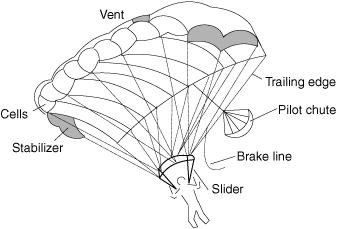- parachute
- An umbrella-shaped area of fabric for producing drag. The fabric body is the canopy, constructed of a number of tapering strips, called gores, which meet at the top like slices of an orange. A hole at the top, called a vent, allows air to flow through, thereby helping to keep the parachute steady. Fastened firmly between the gores are strong cords, called shrouds, which distribute the load evenly over the canopy. Ribbon parachutes (ribbon parachute) have a canopy built of strips joined only at the top. This design retards the aircraft’s speed on landing. Round parachutes are designed to produce drag and stabilize loads dropped from an aircraft. The round parachute also is used in older aircraft with extremely high landing speeds to help slow the aircraft. Square parachutes, used for skydiving, are constructed of fabric and designed to behave like an airfoil. They are extremely maneuverable. The three main types of parachute packs are the seat pack, back pack, and observer. The observer parachute clips onto the lungs of the harness and is positioned on the wearer’s chest. Emergency parachutes are also normally positioned on the wearer’s chest. Parachutes used to retard the aircraft’s speed on landing are known as tail parachutes, tail chutes, or drag chutes. The parachutes may be used by crews or troops and for dropping supplies, providing anti-spinning properties, and slowing down aircraft or even bombs.

 Tail/drogue parachute
Tail/drogue parachute
Aviation dictionary. 2014.
